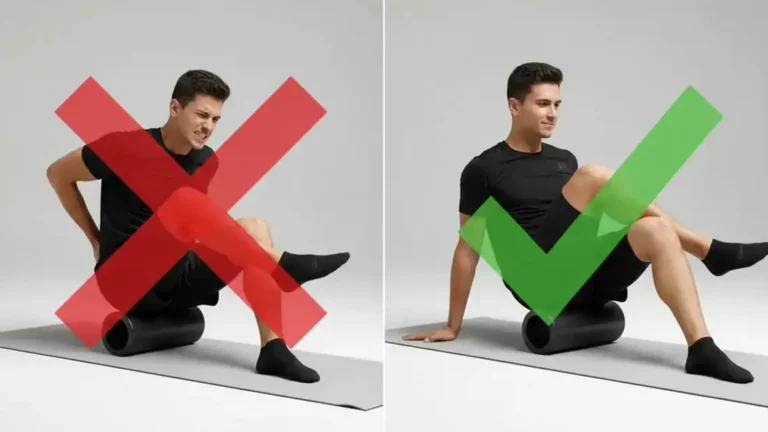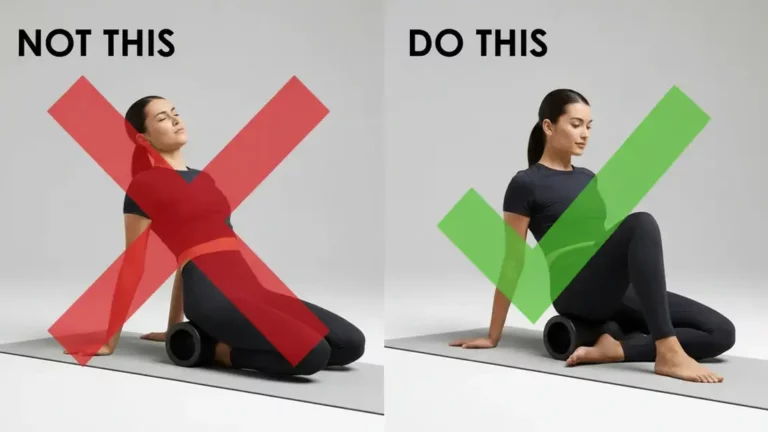Have you ever crushed a workout, feeling like a superhero, only to be ambushed by crippling muscle soreness the next day?
That’s Delayed Onset Muscle Soreness (DOMS), a sneaky gremlin affecting up to 80% of regular exercisers, and it can sideline you for days.
While everyone reaches for protein shakes and ice baths, elite athletes have a secret weapon – breathing for muscle recovery.

Specific breathing techniques, like diaphragmatic breathing (belly breathing), accelerate recovery by targeting the root causes of soreness, inflammation, and fatigue.
How?
Diaphragmatic breathing activates your rest-and-digest mode, helping your muscles recover.
This guide dives into the science-backed breathing strategies that minimize muscle soreness, reduce inflammation, and optimize your recovery.
Consider it your secret weapon in the war against DOMS!
Key Takeaway
Breathing isn’t just about staying alive; it’s a powerful tool you can use to optimize your muscle recovery and get back to training faster.
5 Science-Backed Ways Breathing Supercharges Your Muscle Recovery
Okay, so you’re on board with the idea that breathing might help your muscles recover.
But how does it actually work?
Is it just some woo-woo relaxation technique?
Nope! There’s real science behind it.
Here are 5 ways that breathing supercharges your muscle recovery:
1. Boosts Microcirculation – Delivering the Goods Where They’re Needed
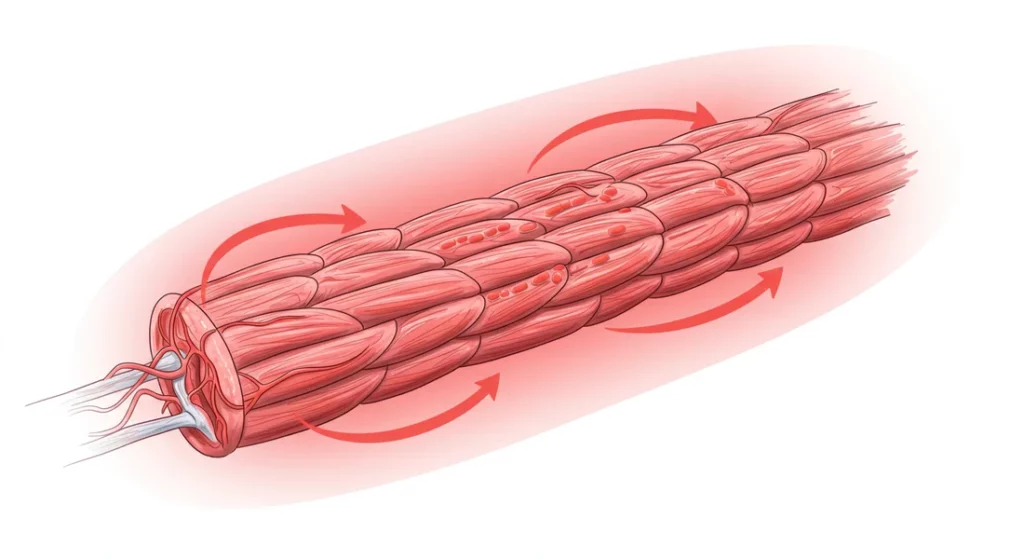
Think of your muscles as tiny construction sites after a tough workout.
They need building materials (oxygen and nutrients) to repair the damage. The problem?
Sore, inflamed muscles often have restricted blood flow, like a traffic jam on the way to the site.
That’s where breathing comes in.
Deep, diaphragmatic breathing acts like a pump, like clearing the traffic jam and delivering those essential building blocks right to where they’re needed.
More blood flow = faster repair!
For example, after a particularly grueling leg day, I noticed that taking 10 minutes to do diaphragmatic breathing significantly reduced the throbbing sensation in my quads the next day.
It felt like the blood was actually circulating better.
2. Combats Inflammation – Taming the Fire Within
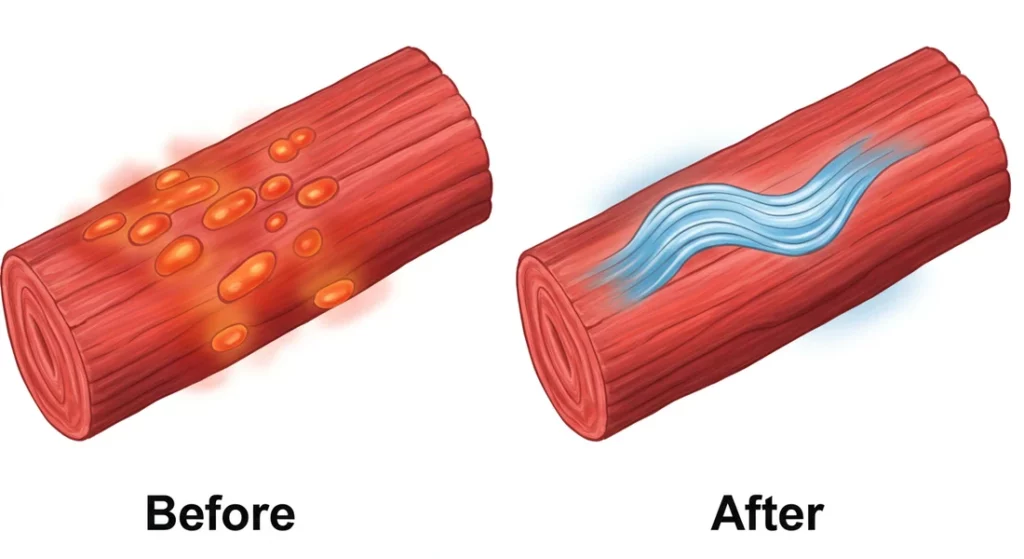
Inflammation is a necessary part of the healing process, but too much inflammation can actually hinder recovery, like a wildfire that gets out of control.
Certain breathing techniques, particularly those that activate the parasympathetic nervous system (your ‘rest and digest’ mode), can help regulate the inflammatory response, preventing it from spiraling out of control and allowing your muscles to heal more efficiently.
It’s like having a team of firefighters on standby, ready to put out the flames before they cause too much damage.
3. Balances Hormones – Saying Goodbye to Stress-Induced Soreness
Cortisol, the stress hormone, is public enemy number one when it comes to muscle recovery.
High cortisol levels can break down muscle tissue and interfere with the repair process.
It’s like pouring gasoline on a construction site!
The good news?
Mindful breathing exercises have been shown to lower cortisol levels, creating a more favorable hormonal environment for recovery.
Imagine replacing that gasoline with water, allowing the construction crew to get back to work.
4. Activates Muscle Repair – Helping Your Muscles Rebuild Stronger (If Research Supports)
This one is still being researched, but some evidence suggests that certain breathing techniques might influence the activation of satellite cells.
These are like stem cells for your muscles, playing a crucial role in repairing damaged muscle fibers, like having a team of specialized builders ready to reconstruct any damaged walls.
While more research is needed, the potential is exciting!
It’s a bit like discovering a new tool that could revolutionize the construction process, but we need more evidence to confirm its effectiveness.
5. Removes Metabolic Waste – Flushing Out the Gunk
During intense exercise, your muscles produce metabolic waste products like lactic acid.
While the impact of lactic acid on DOMS has been debated, effectively removing these waste products is essential for optimal muscle function, like clearing away debris from the construction site.
Deep breathing helps to improve lymphatic drainage and facilitate the removal of metabolic waste, leaving your muscles feeling refreshed and rejuvenated.
It’s like having a powerful cleaning crew that sweeps away the gunk and allows your muscles to function at their best.
Key Takeaway:
Breathing isn’t just some airy-fairy relaxation method; it’s a scientifically proven way to influence key physiological processes that are essential for muscle recovery.
3 Powerhouse Breathing Techniques to Banish Post-Workout Soreness
Now that you know why breathing works for muscle recovery, let’s get practical!
Here are 3 powerhouse breathing techniques you can use to banish post-workout soreness and get back to your peak performance:
1. Diaphragmatic Breathing (Belly Breathing) – The Foundation of Recovery
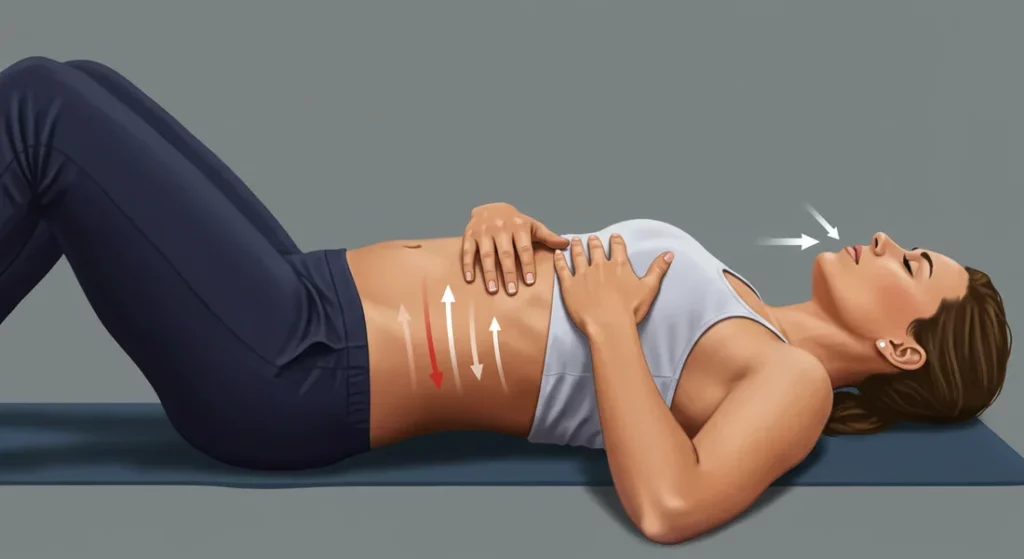
Diaphragmatic breathing is the cornerstone of effective muscle recovery.
It promotes relaxation, reduces inflammation, and improves blood flow.
Here’s how to do it:
- Benefits:
- Reduces inflammation
- Improves blood flow
- Activates the parasympathetic nervous system (rest and digest)
- Steps:
- Find a Comfortable Position: Lie on your back with your knees bent or sit comfortably in a chair.
- Place Your Hands: Place one hand on your chest and the other on your belly, just below your ribs.
- Inhale Slowly Through Your Nose: Focus on breathing deeply into your belly, allowing it to rise while keeping your chest relatively still. You should feel your belly expand more than your chest.
- Exhale Slowly Through Your Mouth: Gently exhale through your mouth, allowing your belly to fall.
- Repeat: Continue breathing deeply for 5-10 minutes, focusing on the rise and fall of your belly.
- Timing:
- Immediately after your workout (during your cool-down).
- Before bed to promote relaxation and improve sleep quality.
- Variations:
- Seated: Can be done anywhere, anytime.
- Lying Down: Easier to focus on belly breathing.
- With Guided Meditation: Use a guided meditation app for added relaxation.
- Cues:
- Imagine you’re filling a balloon in your belly with air.
- Make sure your shoulders are relaxed.
- Don’t force the breath; let it flow naturally.
Testimonial: Diaphragmatic breathing has been a game-changer for my recovery. I used to feel incredibly stiff after lifting weights, but now I recover much faster. – John S.
2. Box Breathing – Finding Calm in the Chaos
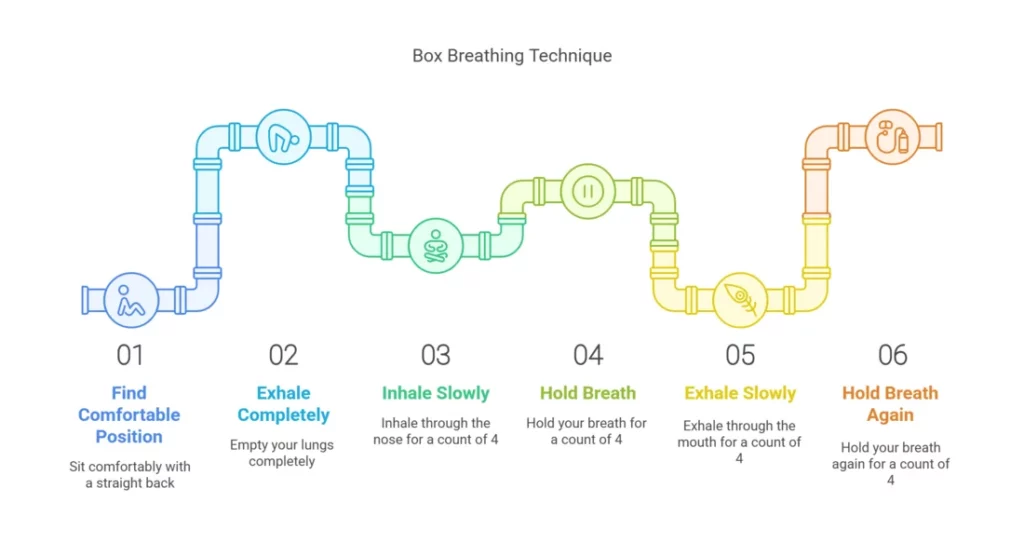
Box breathing, also known as square breathing, is a powerful technique for reducing stress and promoting relaxation.
It’s especially helpful after intense workouts when your nervous system is still revved up.
- Benefits:
- Reduces stress and anxiety
- Improves focus and concentration
- Promotes relaxation
- Steps:
- Find a Comfortable Position: Sit comfortably with your back straight.
- Exhale Completely: Empty your lungs completely.
- Inhale Slowly: Inhale slowly through your nose for a count of 4.
- Hold Your Breath: Hold your breath for a count of 4.
- Exhale Slowly: Exhale slowly through your mouth for a count of 4.
- Hold Your Breath: Hold your breath again for a count of 4.
- Repeat: Continue this cycle for 5-10 minutes.
- Timing:
- Anytime after your workout, especially if you’re feeling stressed or anxious.
- Variations:
- Adjust the Count: Start with a count of 4 and gradually increase it as you become more comfortable.
- Visualize: Imagine breathing in positive energy and exhaling negative energy.
Key Takeaway: Box breathing helps calm your nervous system, reducing stress hormones that can hinder muscle recovery.
3. Pursed-Lip Breathing – Taking Control of Your Breath
Pursed-lip breathing is a simple technique that can help you control your breathing rate and improve oxygen exchange.
It’s particularly useful during your cool-down to help you recover from exertion.
- Benefits:
- Controls breathing rate
- Improves oxygen exchange
- Reduces shortness of breath
- Steps:
- Relax Your Neck and Shoulders: Sit comfortably with your neck and shoulders relaxed.
- Inhale Slowly Through Your Nose: Inhale slowly through your nose.
- Exhale Slowly Through Pursed Lips: Exhale slowly through pursed lips (as if you’re whistling). Make your exhale twice as long as your inhale.
- Repeat: Continue this cycle for 5-10 minutes.
- Timing:
- During your cool-down, immediately after your workout.
5-Minute Post-Workout Breathing Recovery Plan

This simple protocol will help you maximize muscle recovery and minimize soreness.
The Plan:
- Immediately After Your Workout (During Cool-Down):
- Diaphragmatic Breathing: 3-5 minutes.
- Focus on slow, deep breaths, expanding your belly with each inhale.
- Visualize oxygen flowing to your tired muscles.
- Diaphragmatic Breathing: 3-5 minutes.
- 1-2 Hours Later (While Relaxing):
- Box Breathing: 2-3 minutes.
- Inhale for 4, hold for 4, exhale for 4, hold for 4.
- Focus on calming your mind and reducing stress.
- Box Breathing: 2-3 minutes.
- Before Bed (To Promote Sleep):
- Diaphragmatic Breathing: 5 minutes.
- Lie on your back with your knees bent.
- Let your body relax completely with each exhale.
- Diaphragmatic Breathing: 5 minutes.
Why This Works:
- Diaphragmatic breathing immediately post-workout helps to improve blood flow and reduce inflammation in your muscles.
- Box breathing later in the day helps to calm your nervous system and promote relaxation, which is essential for recovery.
- Diaphragmatic breathing before bed can help you fall asleep faster and improve the quality of your sleep, further enhancing muscle repair.
Tips for Success:
- Be Consistent: The more consistently you follow this protocol, the better your results will be.
- Find a Quiet Space: Minimize distractions so you can focus on your breathing.
- Listen to Your Body: If you feel dizzy or uncomfortable, stop and rest.
- Make it a Habit: Integrate this protocol into your routine like brushing your teeth.
DOMS Got You Down? Breathing to the Rescue!
So, you followed your workout plan, but now you’re paying the price with that familiar muscle soreness.
What’s the deal with DOMS, and how can breathing help?
What is DOMS, Anyway?
DOMS, or Delayed Onset Muscle Soreness, is that achy, stiff feeling you get in your muscles 12-72 hours after intense or unfamiliar exercise.
It’s caused by microscopic damage to muscle fibers and inflammation.
While it’s a sign that you’ve challenged your muscles, it can also be a real pain (literally!) and limit your ability to train.
How Breathing Eases DOMS
Breathing techniques can help alleviate DOMS in a few key ways:
- Reducing Inflammation: As we discussed earlier, certain breathing techniques can help regulate the inflammatory response, preventing it from becoming excessive.
- Improving Blood Flow: Increased blood flow delivers nutrients to damaged muscle tissues and helps remove waste products.
- Promoting Relaxation: Relaxation can help reduce muscle tension and pain.
Specific Breathing Exercises for DOMS Relief
While all the breathing techniques we’ve discussed can be helpful, here are a few that are particularly effective for DOMS:
- Gentle Diaphragmatic Breathing: Focus on slow, deep breaths to promote relaxation and improve blood flow.
- Progressive Muscle Relaxation with Breathing: Combine diaphragmatic breathing with progressive muscle relaxation to reduce muscle tension. Tense and relax different muscle groups while breathing deeply.
Since using diaphragmatic breathing after my weightlifting sessions, my DOMS isn’t nearly as bad. I’m able to get back to the gym much sooner! – Mark L.
A frequently asked question,
Will breathing exercises completely eliminate DOMS?
- Answer: While breathing exercises can significantly reduce DOMS, they may not completely eliminate it. DOMS is a complex phenomenon, and other factors like nutrition and sleep also play a role. However, incorporating breathing techniques into your recovery routine can definitely make a noticeable difference.
Avoid These 3 Common Breathing Mistakes After Your Workout
You’re doing your best to breathe your way to faster muscle recovery, but are you accidentally sabotaging your efforts?
Here are 3 common mistakes to avoid, along with how to fix them:
- Shallow Breathing:
- The Mistake: Breathing only into your chest, instead of engaging your diaphragm.
- Why It Matters: Shallow breathing limits oxygen intake and doesn’t fully activate the parasympathetic nervous system.
- The Fix: Focus on expanding your belly with each inhale (diaphragmatic breathing!). Place a hand on your belly to make sure its expanding during breaths.
- Holding Your Breath:
- The Mistake: Holding your breath during any part of the breathing exercise.
- Why It Matters: Holding your breath creates tension and prevents proper oxygen exchange.
- The Fix: Maintain a smooth, continuous flow of breath throughout the exercise.
- Being Inconsistent:
- The Mistake: Only practicing breathing exercises sporadically.
- Why It Matters: Like any skill, breathing for muscle recovery requires consistent practice to see results.
- The Fix: Make breathing exercises a regular part of your post-workout routine. Set a reminder or schedule it into your calendar.
Rather than holding your breath, maintain a consistent, rhythmic flow of air. Aim for a smooth transition between each inhale and exhale.
Tools and Resources to Enhance Your Breathing Practice (Optional)
Want to take your breathing practice to the next level?
Here are a few tools and resources that can help:
- Breathing Apps:
- Calm: Offers guided breathing exercises, meditation programs, puzzles, and sleep stories. Brings calm into your life.
- Headspace: Similar to Calm, with a focus on mindfulness and meditation. Achieve a new level of calm and fulfillment.
- Pranayama Free – Breath Guru: Offers a variety of breathing exercises specifically designed for different purposes.
- Breathing Exercise Devices:
- Inhale Respiratory Trainer: A breathing trainer that helps improve lung capacity and respiratory strength.
- POWERbreathe Medic: A device that provides resistance during inhalation, strengthening your breathing muscles.
- Other Resources:
Please note: As an Amazon Associate, I earn from qualifying purchases. This means I may receive a small commission if you purchase through these links, at no extra cost to you. This helps support the blog and allows me to continue providing valuable content.
Beyond the Gym – The Ripple Effects of Breathing Techniques
While this guide focuses on muscle recovery, the benefits of these breathing techniques extend far beyond the gym.
By incorporating these practices into your daily routine, you may also experience:
- Stress Reduction: Breathing exercises can help calm your nervous system and reduce feelings of stress and anxiety.
- Improved Sleep: Regular breathing practice can promote relaxation and improve sleep quality.
- Enhanced Focus: Certain breathing techniques can help improve focus and concentration.
- Overall Well-Being: By reducing stress and improving sleep, breathing exercises can contribute to a greater sense of overall well-being.
Frequently Asked Questions (FAQ)
Still have questions about breathing for muscle recovery?
Here are some common questions and answers:
- Q: How long should I practice breathing exercises after a workout?
- A: Aim for at least 5-10 minutes of breathing exercises immediately after your workout, and another 5-10 minutes later in the day.
- Q: Is it normal to feel dizzy when doing deep breathing?
- A: It’s not uncommon to feel slightly dizzy when you first start practicing deep breathing. If you feel dizzy, stop and rest. As you become more accustomed to the exercises, the dizziness should subside.
- Q: Can breathing exercises completely eliminate muscle soreness?
- A: While breathing exercises can significantly reduce muscle soreness, they may not completely eliminate it. Other factors like nutrition and sleep also play a role.
- Q: What’s the best time of day to practice these techniques?
- A: The best time to practice breathing exercises is whenever you can fit them into your schedule. However, practicing before bed can be particularly helpful for promoting relaxation and improving sleep.
- Q: Are there any risks associated with these breathing exercises?
- A: Breathing exercises are generally safe for most people. However, if you have any underlying health conditions, such as asthma or COPD, it’s always a good idea to talk to your doctor before starting a new breathing practice.
- Q: Can breathing exercises help with other types of pain, such as joint pain?
- A: While breathing exercises are primarily known for their benefits in muscle recovery, they can also help with other types of pain by reducing stress, promoting relaxation, and improving blood flow.
- Q: What do I do if I am unable to perform the “belly breathing”?
- A: Some people find it difficult to engage the belly breathing. It requires practice and patience. If you do have any concerns, seek a healthcare professional.
Conclusion – Breathe Your Way to Faster Muscle Recovery
You’ve now unlocked the secrets to using breathing techniques for faster muscle recovery!
Remember, breathing isn’t just about staying alive; it’s a powerful tool you can use to optimize your body’s natural healing processes.
By incorporating the techniques and protocol outlined in this guide, you can:
- Reduce inflammation
- Improve blood flow
- Balance hormones
- Minimize DOMS
- Get back to training sooner
Ready to experience the difference?
Start implementing your 5-Minute Post-Workout Breathing Recovery Plan today and say goodbye to debilitating soreness!
References
- Ma, X., Yue, Z. Q., Gong, Z. Q., Zhang, H., Duan, N. N., Shi, Y. T., … & Li, Y. F. (2017). The effect of diaphragmatic breathing on attention, negative affect and stress in healthy adults. BMC Psychology, 5(1), 1-10.
- Jafari, H., Gholamrezaei, A., Franssen, M., Van Oudenhove, L., Aziz, Q., Van den Bergh, O., Vlaeyen, J. W. S., & Van Diest, I. (2020). Can Slow Deep Breathing Reduce Pain? An Experimental Study Exploring Mechanisms. National Institutes of Health (NIH) (.gov).
- Tavoian, D., & Craighead, D. H. (2019). Deep breathing exercise at work: Potential applications and impact. Journal of Workplace Behavioral Health, 34(4), 207-221.
Related Posts

